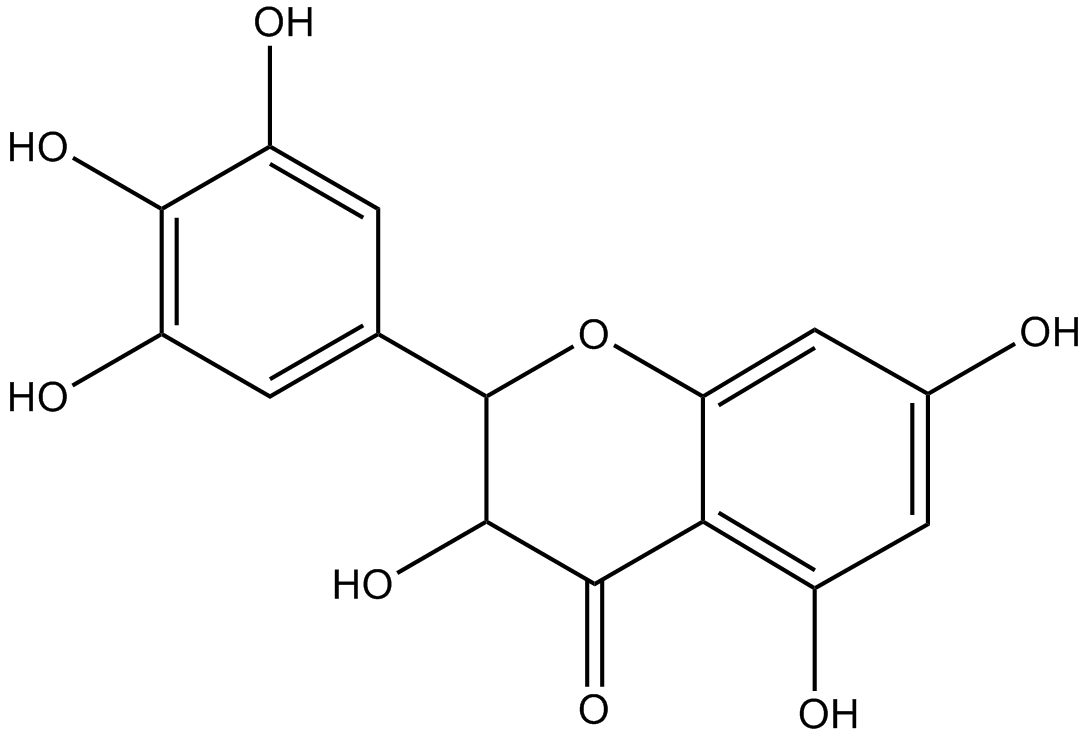Dihydromyricetin (Synonyms: (+)-Dihydromyricetin) |
| Katalog-Nr.GN10583 |
Dihydromyricetin is a natural flavanonol isolated from A. grossedentata and H. dulcis that has antioxidant, antiproliferative, anti-apoptotic, and anti-alcohol intoxication properties.
Products are for research use only. Not for human use. We do not sell to patients.

Cas No.: 27200-12-0
Sample solution is provided at 25 µL, 10mM.
Dihydromyricetin is a natural flavanonol isolated from A. grossedentata and H. dulcis that has antioxidant, antiproliferative, anti-apoptotic, and anti-alcohol intoxication properties[1].
Dihydromyricetin (5, 10, 15; 20; 25; 30μM; 48h) pre-treated MG63 cells for 48 hours, preventing hydrogen peroxide-induced reduction in cell viability. 30μM of Dihydromyricetin during incubation fully blocked the decrease in cell viability caused by 100μM hydrogen peroxide[2]. Dihydromyricetin (12.5, 25, 50μM; 24h) increased the p-STAT3-dependent autophagy by generating ROS-signaling pathways in head and neck squamous cell carcinoma. and inhibiting autophagy could enhance Dihydromyricetin-induced apoptosis in head and neck squamous cell carcinoma[3].
Dihydromyricetin (150mg/kg; po; 4d) showed a strong anti-inflammatory effect on CCl4-induced liver injury in mice, Dihydromyricetin could significantly decrease serum ALT, AST, IL-1β, IL-6 and TNF-α and increase serum albumin, SOD and liver SOD after CCl4 treatment[4].Dihydromyricetin (10mg/kg; ip; 27d) treatment significantly reduced the total number of inflammatory cells in sputum including eosinophils, neutrophils, lymphocytes, and macrophages, as well as the levels of IL-4, IL-5, and IL-13 in BAL fluids, and the secretion of OVA-specific IgE and IgG1 in serum in mice with allergic asthma[5].
[1]. Liu D, Mao Y, Ding L, et al. Dihydromyricetin: A review on identification and quantification methods, biological activities, chemical stability, metabolism and approaches to enhance its bioavailability[J]. Trends in Food Science & Technology, 2019, 91: 586-597.
[2]. Wang Y, Wang W, Qiu E. Protection of oxidative stress induced apoptosis in osteosarcoma cells by Dihydromyricetin through down-regulation of caspase activation and up-regulation of BcL-2[J]. Saudi Journal of Biological Sciences, 2017, 24(4): 837-842.Xu P, Zhang M, Wang X, et al. Antioxidative effect of Quetiapine on acute ultraviolet-B-induced skin and HaCaT cell damage[J]. International Journal of Molecular Sciences, 2018, 19(4): 953.
[3].Fan T F, Wu T F, Bu L L, et al. Dihydromyricetin promotes autophagy and apoptosis through ROS-STAT3 signaling in head and neck squamous cell carcinoma[J]. Oncotarget, 2016, 7(37): 59691.
[4]. Xie J, Liu J, Chen T M, et al. Dihydromyricetin alleviates carbon tetrachloride-induced acute liver injury via JNK-dependent mechanism in mice[J]. World Journal of Gastroenterology: WJG, 2015, 21(18): 5473.
[5].Xu B, Huang S, Wang C, et al. Anti‑inflammatory effects of Dihydromyricetin in a mouse model of asthma[J]. Molecular Medicine Reports, 2017, 15(6): 3674-3680.
Average Rating: 5 (Based on Reviews and 30 reference(s) in Google Scholar.)
GLPBIO products are for RESEARCH USE ONLY. Please make sure your review or question is research based.
Required fields are marked with *




















